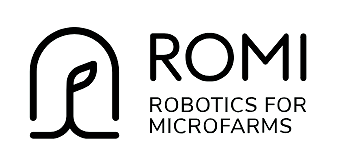
H2020 ROMI Project: Robotics for Microfarms
- Type Project
- Status Filled
- Execution 2017 -2022
- Assigned Budget 3.868.186,25 €
- Scope Europeo
- Main source of financing Horizon 2020
- Project website ROMI
The ROMI project's work has resulted in three "Tech Ready" devices: the Plant Imager, the Cablebot (linked to the Farmer Dashboard), and the Romi Rover. Furthermore, these two research activities have opened up new horizons for future innovation and exploitation.
The Plant Imager is a physical phenotyping station where plants of interest are positioned for automated imaging with a mobile RGB camera. We also offer a suite of integrated analysis processes that perform automated 3D reconstructions. The Plant Imager and its software modules provide a comprehensive environment for automated, quantitative, and accurate 3D phenotyping of single plant shoot architecture. Its development in controlled laboratory environments is being finalized for future dissemination in research laboratories. However, its use in controlled agricultural environments, such as greenhouses, is anticipated as a medium-term application.
The Cablebot is a camera that automatically moves along a cable to collect images of crops. The device is linked to the Farmer Dashboard, the web interface for visualizing and analyzing image data. The software module maps crop rows, locates and identifies individual plants, and extracts their growth curves. As part of ongoing research activities, we are also investigating crop growth prediction and crop placement optimization.
The Romi Rover helps gardeners keep their orchards weed-free. It regularly weeds the soil surface, preventing small weeds from taking root. It can perform this task almost autonomously and requires only minor changes to the farm's layout. It is designed for orchards 70 to 110 cm wide and crops up to 50 cm tall. The robot requires weekly weeding to keep the weed population under control.
The ROMI project's research activities are also very productive. We are evaluating new strategies for more open learning in robotics. This includes curiosity-based learning and reinforcement learning, so that robots can intervene robustly and efficiently when dealing with complex and unpredictable situations on farms.
Research on virtual plant models has the potential to significantly accelerate and improve the training of AI systems. These AI systems are necessary for the automatic analysis of plant images to detect their organs (such as flowers, fruits, and stems) and are an essential component of any advanced robotic device.
Across Europe, young farmers are starting small commercial farms and direct sales businesses. These farms can be found in rural, peri-urban, and urban areas. They grow a wide variety of crops (up to 100 different vegetable varieties per year) on small areas (0.01 to 5 ha) using organic farming practices. These farms have proven to be highly productive, sustainable, and economically viable. However, much of the work is done manually, resulting in physically challenging working conditions.
ROMI developed an open, lightweight robotic platform for these microfarms, offering for the first time a weeding robot, a farmer control panel with a cablebot, and a 3D plant imager. With these tools, we can assist these farms with weed reduction and crop monitoring. This reduces manual labor and increases productivity, particularly through advanced planning tools. For example, thanks to ROMI's weeding robot, farmers were able to save 25% of their time. This ground robot and the cablebot also acquire detailed visual information about the crop beds, which is analyzed and displayed in our farmer control app. They produce an integrated, multi-scale image of crop development that helps farmers monitor crops to increase planting and harvesting efficiency.
To this end, ROMI adapted and extended state-of-the-art ground-based and aerial monitoring tools to manage small fields with complex layouts and mixed crops. To achieve this, we: (i) developed, and plan to bring to market, an affordable and multipurpose ground-based robot, (ii) developed a weeding application for this robot that is tailored for organic microfarms, (iii) applied advanced 3D plant modeling and analysis techniques for data acquisition, (iv) integrated AI-based analysis techniques for detailed plant monitoring, (iv) integrated these techniques also into a cablebot for multi-scale crop monitoring, (v) proposed an affordable 3D scanner for plant phenotyping, and (vii) tested the efficacy of our solution under real-world field conditions at the Chatelain market farm.
Across Europe, young farmers are establishing small farms. These farms are found in rural, peri-urban, and urban areas. They grow a wide variety of crops (up to 100 different vegetable varieties per year) on small areas (0.01 to 5 ha) using organic farming practices. These farms have proven to be highly productive, sustainable, and economically viable. However, much of the work is done manually, resulting in physically demanding working conditions.
ROMI will develop an open, lightweight robotic platform for these microfarms. We will assist these farms with weed control and crop monitoring. This will reduce manual labor and increase productivity. Thanks to ROMI's weeding robot, farmers will save 25% of their time. This robot will also collect detailed information from sample plants and will be paired with a drone that gathers more comprehensive crop-level information. Together, they will generate an integrated, multi-scale picture of crop development that will help farmers monitor it for more efficient harvesting. To do this, ROMI will need to adapt and expand state-of-the-art ground-based and aerial monitoring tools to manage small fields with complex layouts and mixed crops.
To this end, we will: (i) develop and commercialize an affordable, multipurpose ground robot; (ii) develop a weeding application for this robot, tailored to organic microfarms; (iii) apply advanced 3D plant modeling and analysis techniques to field data acquisition; (iv) integrate these analysis techniques into the robot for detailed plant monitoring; (iv) integrate these techniques into the NERO aerial drone for multi-scale crop monitoring; (v) extend the robot with novel adaptive learning techniques to improve sensorimotor control of the plant monitoring application; and (vii) test the effectiveness of our solution under real-world field conditions.
The tools developed during the project contribute to the development of an agricultural model that combines environmental, economic, and social sustainability. First, they support small farms practicing agroecology and polyculture. In fact, operational studies showed that the ROMI Rover was one of the few weeding solutions adapted to vegetable microfarm setups. Furthermore, it remains relatively affordable compared to most robotic weeding solutions.
Likewise, the Farmer Dashboard is one of the few technologies focused on monitoring plant growth. However, it can help greenhouse growers of vegetables, strawberries, ornamental plants, and herbaceous/aromatic plants optimize their production and reduce intrant use. The use of sensors and advanced modeling capabilities in ROMI can therefore facilitate the management of complex agricultural environments. ROMI tools can thus promote productivity and the adoption of agroecological practices, even on microfarms.
ROMI devices also support the development of plant research, which involves the analysis of plant characteristics (phenotyping). Currently marketed automated phenotyping devices are typically high-throughput and expensive, so they are reserved for phenotyping professionals. However, the 3D plant imager offers average throughput and is more affordable. Therefore, it can be used by other types of scientists, including those studying small or medium-sized plants. The grower dashboard could also boost plant research, especially in experimental platforms. Scientists performing varietal selection, for example, closely monitor plant growth manually. However, devices that automate plant data collection are faster and more reliable than manual collection. Therefore, the 3D plant imager and the grower dashboard can support plant research in laboratories and experimental centers.
Finally, ROMI tools (hardware and software) are available under a free license to achieve the greatest possible impact. This model makes the results accessible to small farms around the world and facilitates collaboration between farmers, scientists, engineers, and industry. In addition to promoting the development of sustainable agricultural models and plant research, ROMI has developed, and will continue to develop, synergies between them.
- INSTITUT D'ARQUITECTURA AVANCADA DE CATALUNYA (IAAC)






